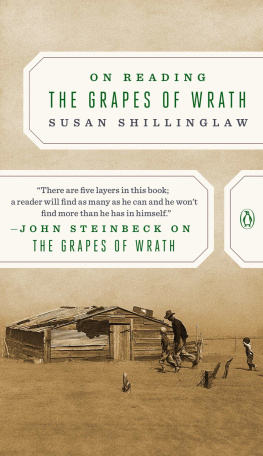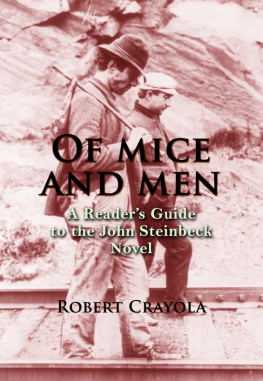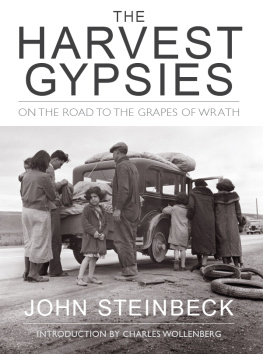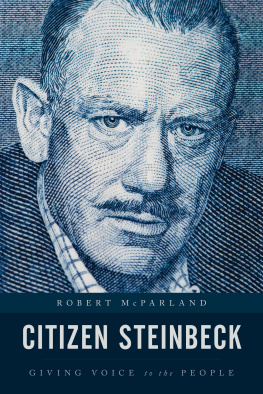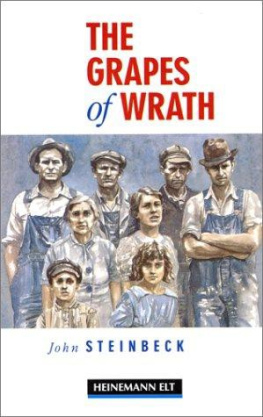Ann Malaspina - John Steinbeck
Here you can read online Ann Malaspina - John Steinbeck full text of the book (entire story) in english for free. Download pdf and epub, get meaning, cover and reviews about this ebook. year: 2018, publisher: Infobase Publishing, genre: Non-fiction. Description of the work, (preface) as well as reviews are available. Best literature library LitArk.com created for fans of good reading and offers a wide selection of genres:
Romance novel
Science fiction
Adventure
Detective
Science
History
Home and family
Prose
Art
Politics
Computer
Non-fiction
Religion
Business
Children
Humor
Choose a favorite category and find really read worthwhile books. Enjoy immersion in the world of imagination, feel the emotions of the characters or learn something new for yourself, make an fascinating discovery.
- Book:John Steinbeck
- Author:
- Publisher:Infobase Publishing
- Genre:
- Year:2018
- Rating:5 / 5
- Favourites:Add to favourites
- Your mark:
- 100
- 1
- 2
- 3
- 4
- 5
John Steinbeck: summary, description and annotation
We offer to read an annotation, description, summary or preface (depends on what the author of the book "John Steinbeck" wrote himself). If you haven't found the necessary information about the book — write in the comments, we will try to find it.
Once called a giant of American letters, John Steinbecks novels, including Of Mice and Men,The Grapes of Wrath, and The Red Pony, continue to have broad appeal and continuing relevance today. Learn more about Steinbecks
John Steinbeck — read online for free the complete book (whole text) full work
Below is the text of the book, divided by pages. System saving the place of the last page read, allows you to conveniently read the book "John Steinbeck" online for free, without having to search again every time where you left off. Put a bookmark, and you can go to the page where you finished reading at any time.
Font size:
Interval:
Bookmark:
Copyright 2018 by Infobase
All rights reserved. No part of this publication may be reproduced or utilized in any form or by any means, electronic or mechanical, including photocopying, recording, or by any information storage or retrieval systems, without permission in writing from the publisher. For more information, contact:
Chelsea House
An imprint of Infobase
132 West 31st Street
New York NY 10001
ISBN 978-1-4381-8574-3
You can find Chelsea House on the World Wide Web
at http://www.infobase.com
John Steinbeck took to the road in an old bakery truck in the summer of 1936. The San Francisco News had hired the 34-year-old writer to report on the migrant laborers in the agricultural fields that spread like carpets across the valleys of California. The migrants were refugees of the Dust Bowl disaster in the Great Plains, brought on by extreme drought and made worse by the economic Depression. After losing their homes and farms, they drove to California with hopes of starting their lives over in a land of plenty. Now they were traveling up and down the state, following the harvests of grapes, peaches, lettuce, and other crops.
Steinbeck was already a promising novelist with an interest in labor issues. His first successful novel, Tortilla Flat, was published a year earlier in 1935. The comic novel is about a group of unemployed veterans who don't want to work in the fish canning factories in Monterey, the only jobs available to them, and would rather talk and drink together. Another novel, In Dubious Battle, followed in 1936. The story about a migrant apple workers' strike during the Great Depression shows Steinbeck's empathy for laborers who stand up to their bosses, the banks, police, and society in order to get fair wages. Because Steinbeck could mix a good story and compelling characters with dynamic social issues, the novels were popular with readers. No wonder the newspaper hired Steinbeck to write about the Dust Bowl refugees. He wasn't afraid to raise controversy or challenge his readers with uncomfortable truths.
Steinbeck stopped at government camps and roadsides where migrant workers and their families had set up makeshift homes. He was shocked to discover the harsh reality of their plight. The Dust Bowl refugees arrived in California "bewildered and beaten and usually in a state of semi-starvation," he wrote in one article, later collected in The Harvest Gypsies: On the Road to The Grapes of Wrath. Hired as cheap labor, they worked long, back-breaking hours for little pay. They did not plant new roots, but instead were forced into a desperate vagabond existence. "On side roads and near rivers...the squalid, filthy squatters' camp will have been set up, and the orchards will be filled with pickers and cutters and driers," he wrote. When an orchard or field was picked clean, the migrants rolled up their blankets, threw dirt on the cooking fires, and moved on to the next harvest.
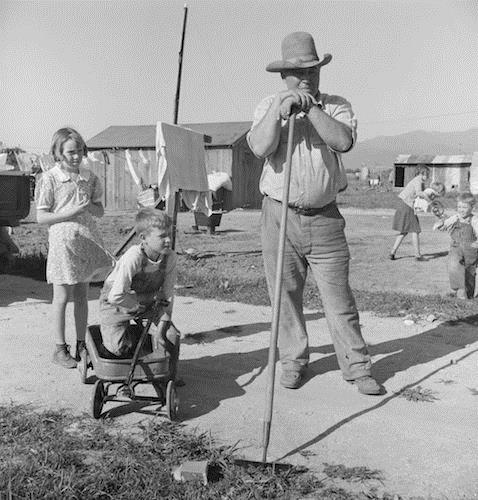
Outskirts of Salinas, California: a rapidly growing settlement of lettuce workers. Here, a migrant family from Oklahoma settling in a makeshift dwelling. April 1939, photo by Dorothea Lange.
Source: Library of Congress. Prints and Photographs Division.
As a working journalist, Steinbeck took notes. He saw a three-year-old boy with a stomach distended from malnutrition and mothers too weak to clean the family's clothes. He took down what people had to eat. "Family of sevenBeans, fried dough. Family of sixFried cornmeal. Family of fiveOatmeal mush." He interviewed mothers who'd lost their babies because there was no milk. He talked to families who relied on their children to work in the fields, because the parents were sick and malnourished.
To make matters worse, the migrant workers faced discrimination from the locals. "The migrants are needed, and they are hated," Steinbeck writes. One boy in a squatters camp told Steinbeck, "When they need us they call us migrants, and when we've picked their crops, we're bums and we got to get out." Unlike traditional immigrant farm workers, the American-born laborers were more aware of their rights, which turned their bosses against them. As Steinbeck observed, "It should be understood that... the old methods of repression, of starvation wages, of jailing, beating and intimidation are not going to work; these are American people."
It wasn't the first time Steinbeck lived among farm laborers. Growing up in Salinas Valley, he was surrounded by large-scale agricultural fields where immigrant workers toiled from dawn until dusk. During high school and college, Steinbeck sometimes found work in the fields alongside them. Yet Steinbeck's family lived in a large house with a white picket fence, and he would never experience the futile hopes and persistent poverty of the fulltime workers. The best he could do was to write about their lives and be an advocate for their struggles.
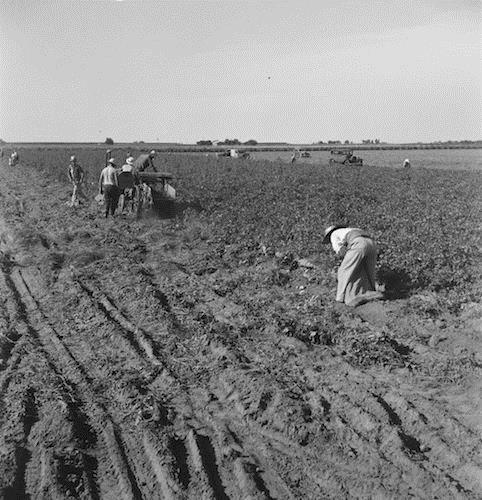
Thousands of migrant workers are employed for harvesting the potato crop of Kern County, California. June 1938, photo by Dorothea Lange.
Source: Library of Congress. Prints and Photographs Division.
One of the great writers of the twentieth century, Steinbeck was a complicated person, and not easily labeled. He was never a radical or a communist, but had great empathy with laborers, migrants, and others who lived on society's margins. Aware of the deep social inequalities in American society, he disapproved of the divide between the haves and the have-nots. Still, he was not starry-eyed or naive. In his fiction, Steinbeck did not paint all poor workers as goodand all rich bosses as bad. Still, social inequity and the imbalance of wealth and power was a persistent theme in Steinbeck's greatest works. His characters were not just individuals, but part of larger groups caught by the movements of history, the economy, and even weather such as drought and floods.
In a career spanning many decades, Steinbeck constantly explored new subjects, experimented with form, and tried new genres. He wrote screenplays, scripts for the theater, nonfiction, and thousands of letters to friends and acquaintances. Many of his stories came from his own experience and interests. He wrote about war, marine biology, jazz, politics, myths, and his own family. He wrote short stories, long and short novels, plays, screenplays, nonfiction, journals, and thousands of lettersto presidents, first ladies, and old friends. Steinbeck published around 30 books of fiction and nonfiction. At least 14 of his novels and stories became films.
Whatever his subject or genre, Steinbeck focused on the human condition. He looked for what made people vulnerable and humanand, in doing so, still captivates his readers to this day. "And, of course, people are interested only in themselves. If a story is not about the hearer he will not listen. And here I make a rulea story is about everyone or it will not last," says Lee, one of the characters in his epic novel East of Eden about two California families whose lives intersect, at times tragically. Lee is the wise Chinese-American servant who helps both families understand themselves.
Not all his novels were successes, and his reputation was mixed among literary critics. Some thought he did not deserve major literary prizes. But his popularity was strong among readers. His best novels are still being boughtand taught in classroomsmore than a half-century after his death in 1968. In his stories set in the early decades of the twentieth century, readers in the next century recognize their own world, with the same problems of inequality, human frailty, and elusive dreams.
Font size:
Interval:
Bookmark:
Similar books «John Steinbeck»
Look at similar books to John Steinbeck. We have selected literature similar in name and meaning in the hope of providing readers with more options to find new, interesting, not yet read works.
Discussion, reviews of the book John Steinbeck and just readers' own opinions. Leave your comments, write what you think about the work, its meaning or the main characters. Specify what exactly you liked and what you didn't like, and why you think so.



